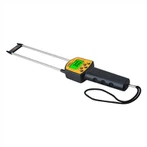Inspections before using the soldering iron
1. Test the resistance size
Before using the soldering iron, measure the resistance of the power plug to determine whether the soldering iron is usable.
The resistance of the soldering iron is several thousand ohms, which means it is usable. If the resistance is zero or infinite, it cannot be used. If the resistance is zero, it means there is a short circuit inside the soldering iron, and if the resistance is infinite, it means there is an open circuit inside the soldering iron.
2. Carry out tin plating protection
When using a new soldering iron for the first time, make sure the soldering iron tip is bright, apply electricity to heat and melt the solder, and dip it in rosin. Contact the soldering wire multiple times to evenly coat the soldering iron tip with a layer of solder. It can facilitate subsequent use and prevent oxidation of the soldering iron tip.
Old electric soldering irons have been used for a long time, and there will be a layer of oxide on the surface of the soldering iron tip, making it difficult for the soldering iron tip to absorb tin.
You can use fine sandpaper or a file to remove the oxide on the surface of the soldering iron tip to make the surface bright. Then, according to the treatment method of a new electric soldering iron, evenly coat the surface of the soldering iron tip with a layer of solder.
3. The problem that the soldering iron does not eat tin
When the soldering iron fails to eat tin, there is generally no need to consider whether it is caused by insufficient oxygen. Oxygen has nothing to do with the heating of the soldering iron. The soldering iron heats and melts the solder wire through alternating current.
The reason why the soldering iron does not eat tin is because the soldering iron is powered on for too long without being used, which will accelerate the oxidation of the soldering iron core and cause it to burn out, shortening its service life. At the same time, it will cause the soldering iron tip to be heated for a long time and oxidized or burned.
This leads to the problem that the soldering iron does not eat tin. In the process of not eating tin, an oxidation reaction occurs, and a chemical reaction occurs between substances and oxygen, in which oxygen provides oxygen.
When the power-on time is too long and the temperature rises sharply, reaction conditions are provided for the oxidation reaction, which will accelerate the oxidation rate of the soldering iron tip and core of the electric soldering iron.






